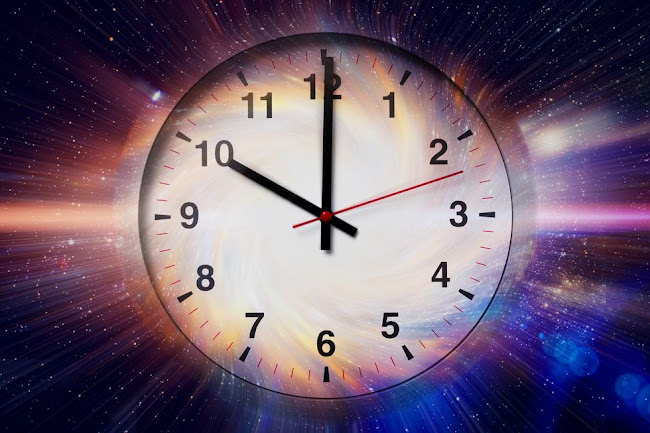Isaac Newton’s picture of a universally ticking clock more or less sums up how we understand time: the arrow of time only moves forward, cruelly robbing us of the chance to revisit our past.
Not everyone takes that for granted though, as evidenced by Albert Einstein, whose 1905 theory of special relativity stated that time is an illusion that moves relative to an observer. Today, physicists like Julian Barbour, who has written a book on the illusion of time, say change is real, but time is not; time is only a reflection of change. And just last week, a team of physicists published a new paper suggesting that quantum systems can move both forward and backward in time.
To understand why scientists previously established that time knows only one direction—forward—we need to examine the second law of thermodynamics. It states that within a closed system, the entropy of the system (that is, the measure of disorder and randomness within the system) remains constant or increases. If our universe is a closed loop, curled up like a ball, its entropy can never decrease, meaning the universe will never return to an earlier point. But what if the arrow of time looked at phenomena where entropy changes are small?
“THE SECOND LAW OF THERMODYNAMICS IS A STATISTICAL LAW...IT IS TRUE ON AVERAGE IN A MACROSCOPIC SYSTEM. IN A MICROSCOPIC SYSTEM, WE MAY SEE THE SYSTEM NATURALLY EVOLVING TOWARD SITUATIONS OF LOWER ENTROPY.”
“Take the case of a gas in a vessel,” says Giulia Rubino, a postdoctoral research fellow at the University of Bristol, and lead author of the new paper that appears in Communications Physics. “Let’s suppose that at the beginning, the gas occupies only half of the vessel. Then imagine that we remove the valve that confined it within half of the vessel, so that the gas is now free to expand throughout the vessel.”
The particles will start to move freely through the whole volume of the vessel. Over time, the gas will occupy the whole vessel. “In principle, there is a non-zero probability that at some point the gas will naturally return to occupy half of the vessel, only this probability gets smaller the larger the number of particles that make up the gas get,” Rubino says. If there were only three gas particles instead of a humongous quantity of gas (comprising billions of particles), it would be possible that these few particles ended up sitting once again in the part of the vessel from where they originally started. “The second law of thermodynamics is a statistical law,” says Rubino. “It is true on average in a macroscopic system. In a microscopic system, we may see the system naturally evolving toward situations of lower entropy.”
She and her colleagues wondered about the consequences of applying this paradigm in the quantum realm. According to the principle of quantum superposition, individual units ( for instance, of light) can exist in two states at once, both as waves and particles, manifesting as one or the other depending on what you’re testing. Rubino’s team looked at a quantum superposition with a state that evolves both backward and forward in time. Measurements showed that more often than not, the system ended up moving forward in time. But for small entropy changes, the system could actually continue to evolve both forward and backward in time.
So how do these complex physics notions translate to the actual human experience? Is it finally time to start packing for a trip backward in time? Hold your horses.
“We humans are macroscopic systems. We cannot perceive these quantum superpositions of temporal evolutions,” Rubino says. For us, time indeed moves forward. It might be the case that the world is slightly undecided though. “At its most fundamental level, the world is made up of quantum systems [which can move forward and backward],” Rubino explains. “Having a deeper understanding of how to describe time flow at the level of these elementary constituents could allow us to formulate more precise theories to describe them and, eventually, to gain a deeper understanding of the physical phenomena of the world which we inhabit.”
Not everyone agrees that the distinction between the macroscopic and microscopic is clear though. Ramakrishna Podila, an assistant professor in the Department of Physics and Astronomy at Clemson University in South Carolina, says that many-particle statistics versus single-particle statistics is a more accurate way to describe things. Even a single particle has its own, unique microstates. Podila thinks that in our quest to understand time, we are putting equations before physical reality—and missing the point.
“Associating the arrow of time with entropy or a quantum mechanical system collapsing (as it is stated in the paper) are not formal statements, but popular methods that are easy to use,” he says. Even that time evolves forward is not an axiom per se, but a theory that astrophysicist Arthur Eddington coined and popularized in 1927. “That these ideas are used does not make them the truth. When we forget the real, underlying physics [the universally accepted axioms], we come up with all sorts of crazy things,” Podila says.
So maybe it is time (and not space) that is the final frontier, despite what the beloved Captain James T. Kirk repeated at the beginning of each Star Trek episode. Or, perhaps spacetime, the idea that space and time fuse together into one interwoven continuum, is. Ever since Einstein formulated his theory of relativity, we stopped perceiving space as a three-dimensional figure and time as a one-dimensional one. “Time became the fourth element of a four-dimensional vector that describes space and time,” says Rubino. It’s a unified, dynamic entity we are still scratching our heads over.


